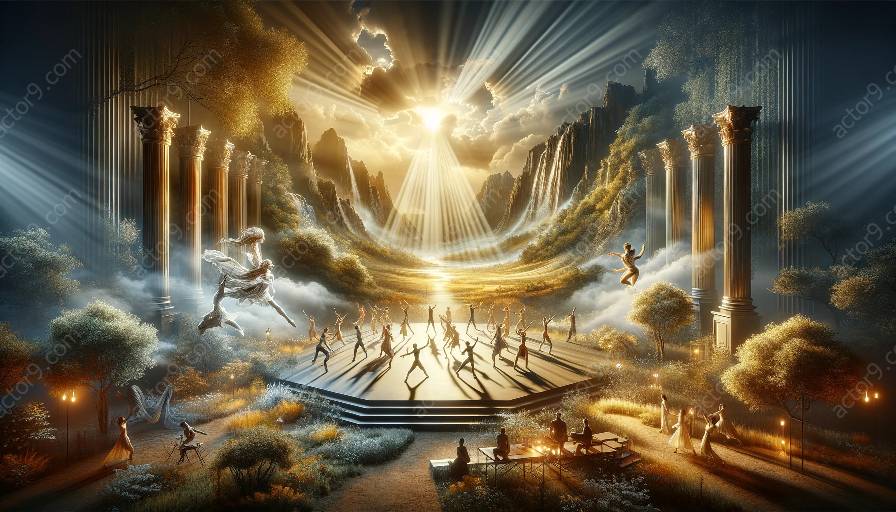Physical theatre is a form of performance that emphasizes the use of physical movement, gesture, and expression as the primary means of storytelling. It often involves the manipulation of space, objects, and the human body to convey narratives and emotions, aiming to create a unique and immersive experience for the audience. Lighting plays a crucial role in physical theatre, as it can be used to blur the boundaries between reality and illusion, enhancing the visual and emotional impact of performances.
Understanding Physical Theatre
Physical theatre is characterized by its non-verbal and highly kinetic nature, often incorporating elements of dance, mime, acrobatics, and other forms of physical expression. It aims to evoke powerful emotional responses and engage the audience on a visceral level. The performers use their bodies as the primary tool for communication, relying on movement, expression, and spatial awareness to convey the intended messages.
The essence of physical theatre lies in its ability to transcend language and cultural barriers, connecting with audiences at a primal level. Through the use of inventive choreography and spatial dynamics, physical theatre performances can transport spectators to alternate realities, provoke introspection, and challenge preconceived notions of what is possible.
The Role of Lighting in Physical Theatre
Lighting design is a vital component of physical theatre, as it serves to amplify the impact of movements, gestures, and emotions portrayed on stage. By manipulating light and shadow, lighting designers can alter the perception of space, time, and mood, creating an immersive environment that blurs the line between the tangible and the ephemeral.
Strategic use of lighting can transform the stage into a canvas where illusions and realities coexist, shaping the audience's perception and enhancing the storytelling experience. Through the interplay of light and darkness, physical theatre performances can evoke a sense of mystery, wonder, and enchantment, captivating the audience and inviting them into the imaginative realm crafted by the performers.
Blurring Boundaries Between Reality and Illusion
One of the most compelling aspects of utilizing lighting in physical theatre is its ability to dissolve conventional perceptions of reality, immersing the audience in an alternate realm where the boundaries between what is real and what is imagined become increasingly ambiguous.
Through the manipulation of light intensity, color, and direction, physical theatre productions can induce a transformative experience, blurring the distinction between the tangible and the illusory. By casting evocative and dynamic lighting patterns, performers can defy gravity, alter their physical forms, and create a heightened sense of drama, effectively submerging the audience in a world where reality is malleable and subject to artistic interpretation.
Techniques and Effects of Using Lighting in Physical Theatre
1. Color Manipulation
The strategic implementation of colored lights can evoke specific moods, atmospheres, and emotional responses, effectively accentuating the narrative and thematic elements of a physical theatre performance. By altering the color palette throughout the show, lighting designers can guide the audience through a spectrum of emotions, amplifying the impact of the performers' movements and expressions.
2. Shadow Play
Playful and dynamic use of shadows can add depth, mystery, and intrigue to physical theatre performances, allowing performers to interact with their own silhouettes and create visually captivating illusions. By casting shadows that defy conventional spatial constraints, the performers can manipulate the audience's perception, blurring the distinction between physical reality and artistic interpretation.
3. Dynamic Lighting Transitions
The seamless transition between different lighting intensities, angles, and focal points can enhance the fluidity and impact of physical theatre movements, creating a sense of continuity and visual coherence. By orchestrating smooth lighting transitions, the performers can execute choreographed sequences with heightened dramatic effect, engaging the audience in a mesmerizing visual journey.
4. Spatial Distortion
Strategic placement and movement of light sources can distort spatial perceptions, providing a surreal and captivating backdrop for physical theatre performances. Lighting designers can create a sense of disorientation, expansion, or contraction within the performance space, blurring the boundaries between the real and the imagined, challenging the audience's understanding of physical reality.
Conclusion
Lighting plays a pivotal role in physical theatre, functioning as a transformative tool that blurs the boundaries between reality and illusion. By harnessing the power of light, physical theatre performances can transcend conventional storytelling, offering audiences an immersive and enchanting experience that captivates the senses and challenges preconceived notions of what is possible.
The strategic use of lighting techniques and effects enables performers to transport audiences into alternate realms, provoke emotional responses, and create visually stunning illusions that redefine traditional notions of reality. When harmoniously integrated with the kinetic prowess of physical theatre, lighting becomes an indispensable medium for crafting evocative narratives and engaging audiences on a profound and transcendental level.




































